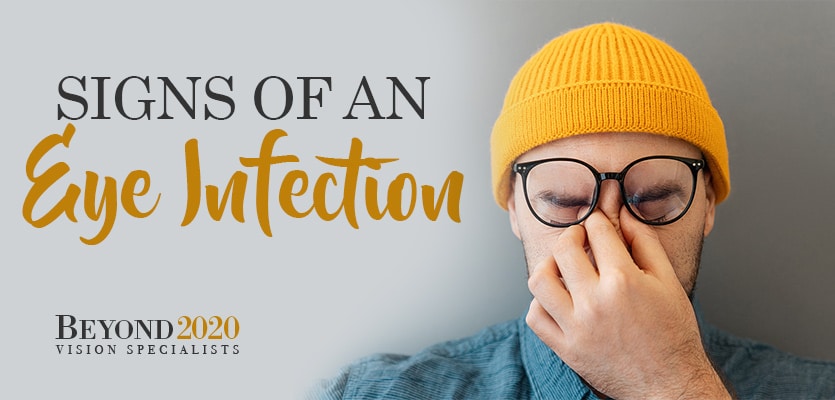Signs of an Eye Infection
Home » Signs of an Eye Infection

Signs of an Eye Infection
Are you wondering why your eyes have been bothering you so much lately? Perhaps they are red and itching or you are experiencing minor pain and swelling along with excess tears. If so, your eyes may be infected. An eye infection can change the appearance of your eyes, affect how they feel, and alter your vision. Some eye infections are relatively minor while others are serious and can lead to a loss of vision if left untreated. While the only way to know for sure whether you have an eye infection is to have your eyes examined by an eye doctor, here is some information about the signs of an eye infection:
What Causes an Eye Infection?
Eye infections can be caused by a number of factors, including irritants, touching the eyes with unclean hands, foreign objects entering one or both eyes, certain medical conditions, and wearing dirty contact lenses. They can also be caused by minor eye injuries, viruses, bacteria, and parasites. Certain eye infections like pink eye are more common in children than adults and can rapidly spread in a classroom or daycare setting when children touch their eyes without first washing their hands. However, eye infections are not limited to children but affect people of all ages.
What Are the Signs of an Eye Infection?
Signs of an eye infection may manifest themselves in the way your eyes look, how they feel and how well you can see. In most cases, the signs are not very hard to spot. However, different parts of your eye may be affected depending on what type of eye infection you have. Here are some of the most common signs of an eye infection:
How Your Eyes May Look with an Eye Infection
An eye infection may affect the color of your eyes. The white part of your eyes may become pink or red as the result of blood vessels widening in that portion of your eyes. Your eyes may look watery and shiny because of hyperactive glands, and your eyelids could become swollen and take on a red-to-purple color. You may also notice a discharge that is clear, yellow, or green in color. Additionally, your eyelids and eyelashes may look and feel crusty at times because of mucus produced by the infection. This is especially true in the mornings.
How Your Eyes May Feel with an Eye Infection
If you are experiencing pain and discomfort in any part of your eyes, you could have an eye infection. This includes burning in your eyes, tender eyelids and any type of painful lump. Your eyes may also be itchy and feel like a foreign object is in one or both of your eyes. Other signs of an eye infection include tender eyelids, sensitivity to light, and your eyes constantly watering to the point that tears are running down your cheeks. Additionally, your eyes may feel like they have sand or grit in them.
How Your Sight May Be Affected by an Eye Infection
An eye infection can also degrade your vision. Objects may look blurry or cloudy to you. You may also notice changes in color and a decrease in peripheral vision. Left untreated, some eye infections can result in a permanent loss of vision.
Types of Eye Infections
There are many types of eye infections, and they can affect different portions of your eye. Eye infections may result from the presence of bacteria, viruses, fungi or parasites. The most common types of eye infections are conjunctivitis, keratitis, blepharitis, and styes. Other types of eye infections include the following:
- Acanthamoeba keratitis
- Cellulitis
- Chlamydia trachomatis
- Corneal ulcers
- Dacryocystitis
- Dacryostenosis
- Endophthalmitis
- Ocular herpes
- Orbital cellulitis
- Uveitis
Conjunctivitis
Conjunctivitis is commonly referred to as pink eye. It is an infection of the conjunctiva, the clear membrane that covers the white part of the eye and lines the eyelid. Children tend to get conjunctivitis frequently as the result of bacteria. A virus is the most common cause of conjunctivitis in adults. Other causes include the common cold. Conjunctivitis typically causes the eye to turn pink or light red. There are three different types of conjunctivitis: irritant conjunctivitis, allergic conjunctivitis, and infective conjunctivitis.
- Irritant conjunctivitis occurs when an irritant or chemical enters the eye that results in soreness or inflammation. The irritant could be something as simple as an errant eyelash or a more harmful substance like excess chlorine in swimming pool water.
- Allergic conjunctivitis occurs whenever an allergen contacts the eye that results in an irritation or inflammation. Typical allergens that cause this type of eye infection include dust, pollen and animal fur or hair.
- Infective conjunctivitis results from a bacterial or viral infection. This typically leads to pink and watery eyes. It can also produce mucus in the eyes and cause the area around the eyelashes to develop a sticky coating.
Keratitis
Keratitis is an inflammation of the cornea, the transparent membrane that covers the front part of the eye where the pupil and iris are located. Keratitis may or may not be caused by an infection. Noninfectious keratitis can be caused by a minor injury such as getting a foreign object in your eye or wearing your contact lenses too long. Infectious keratitis can be caused by bacteria, viruses, and pathogens in water. Mild keratitis can usually be treated with no damage to the eyes, but moderate cases left untreated for a long time period could result in permanent loss of vision.
Blepharitis
Clogged oil glands near the base of eyelashes can sometimes cause eyelids to become infected. This common type of eye infection is known as blepharitis. It usually affects both eyes and may cause itching and burning sensations or feel like a foreign object is in one or both eyes. Blepharitis is not contagious and can usually be treated with no permanent damage to the eyes. However, it can lead to other problems like eyelashes falling out or losing color, scarring of eyelids and excessive tearing or dry eyes. It can also lead to frequent pink eye.
Styes
A stye is a lump or bump on an eyelid or at the base of an eyelash. Styes are typically red in color, filled with pus, and can be quite itchy and painful. Styes are caused by staphylococcal bacteria, a common type of bacteria that lives on your skin. However, it can cause a clogged gland or follicle when transferred to your eyes. There are two types of styes: internal and external. Internal styes are located in your eyelid. As they grow, they push on your eye, which causes pain. External styes are located on your eyelashes or on the outer portion of your eyelids.
What Are the Complications of an Eye Infection?
Complications of an eye infection include blockage of the eye’s drainage system, blisters on the eye, ulcers in the cornea, retina damage and scars. Some eye infections have the ability to provoke glaucoma. Retina damage, scars and ulcers can cause vision loss and total blindness in some cases.
How to Minimize the Risk of an Eye Infection
To prevent eye infections, it is important to take proper care of the eyes and to keep them clean. Bedding should be changed on a regular basis, and there should be no sharing of pillows and towels. Frequent handwashing is also important, and the hands should always be washed before touching the eyes. A person who uses contact lenses should make sure that their lenses are clean and stored in a clean case. Contact lenses should neither be worn when sleeping nor used beyond the recommended time. It is also important to get eye examinations on a regular basis so that abnormalities can quickly be determined and dealt with.
How Do You Get Rid of an Eye Infection?
Some minor eye infections may go away on their own. Others, though, will require medical treatment. When that is the case, different treatments may be required depending on what caused the eye infection and what part of the eye is infected. In many cases, eye drops can be used that target the specific bacterium, virus, or other pathogens that caused the infection. Anyone who thinks they may have an eye infection and wears contact lenses should stop wearing them immediately and only wear glasses until they have consulted with an eye doctor.
Contact a Vision Specialist
If you think you may have an eye infection, you should seek immediate medical treatment. Delaying such treatment may have serious consequences and could result in a loss of vision. Contact Beyond 2020 Vision Specialists today, and we will be glad to schedule an appointment with Dr. Christopher Tumolo who will examine your eyes, determine whether you have an eye infection, and recommend a treatment plan if necessary. Beyond 2020 Vision Specialists serves Odessa, Florida, and all the surrounding areas. We are located in the Suncoast Crossings shopping center at 16230 State Road 54.

